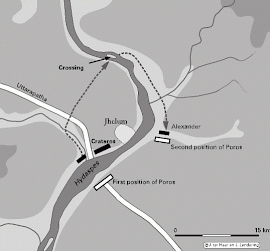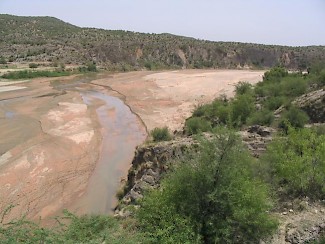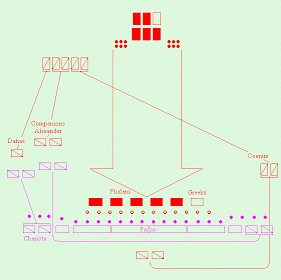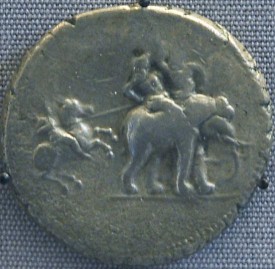Hydaspes (326 BCE)
Q213074Hydaspes (Old Indian Vitaçtā, modern Jhelum): river in Pakistan, famous for a battle of Alexander the Great.

In May 326, the Macedonian king Alexander the Great and his ally, raja Ambhi of Taxila, defeated Porus, a raja who had not been able to surrender himself to Alexander. There were heavy rains - the monsoon seems to have started early - and the river Jhelum, already wide in May because of the melting waters of the Himalayas, became very wide.
Porus thought he'd have a chance, if only he could win time and keep the river, in Antiquity known as Hydaspes or Vitaçtä, between his own army and that of his enemy. This must have been somewehere near modern Jhelum. Scholars have proposed other sites further down the stream (at Haranpur and Jalalpur), but palaeohydrological research has shown that the Jhelum was far from these places until the eighth century CE.

The actual place where the two armies clashed, must have been the place where the Uttarāpatha crossed the river. This was the main road along the Cophen, to Peucelaotis, across the Indus, to Taxila, into the direction of Lahore, and beyond, to Patna on the plains of the Ganges. Essentially, Uttarāpatha is the ancestor of the Grand Trunk Road, but we know that until the sixteenth century, the ford was southwest of the modern bridge. Today, the old crossing is dominated by a large fortress, Mangla.

The battle itself has become famous, but it was in fact a skirmish. Porus was isolated and Alexander employed only one sixth of his forces. What he needed was a surprise crossing, and the rain offered sufficient opportunity. Another element of surprise was that the Macedonian officer Coenus had brought the ships (which had been used to cross the Indus) all the way to the Jhelum. During a stormy night, Alexander and his army slipped away from the Jhelum through a hidden valley, out of sight of Porus.
At dawn, Alexander crossed the Jhelum, a considerable distance upstream from his initial camp. A possible location is near Mangla dam, a modern barrage. This site is not difficult to reach and the west bank offers room to gather ships, yet it is out of sight from the other bank.
 The river Jhelum |
 The river Jhelum |
 Possible site of Alexander's crossing of the Jhelum |
 A modern crossing of the Jhelum |
Unaware of what had happened, and seeing a substantial part of Alexander's army (commanded by Craterus) still on the opposite shore, Porus could not believe the news that the Macedonians had reached the east bank. He sent his son to find out what had happened, but he was killed in action. The fact that it had been raining made it very hard to fight from chariots, a factor that contributed to the defeat of the prince. Alexander proceeded along the river, downstream, towards Porus' army.

The Macedonians had nothing to fear, except for Porus' elephants, a type of army unit that the Macedonians had never encountered before. Porus placed these animals in front of his infantry; on his wings, he stationed his chariots. When the Macedonians reached the place where the Indian king was waiting for them, they deployed their phalanx and moved slowly towards their enemy. Alexander commanded the Companion cavalry and the mounted archers of the Dahae, which were on his right wing. Seeing that his left wing chariots were outnumbered by the Macedonian cavalry, Porus moved his right wing chariots to the left; at that moment, Coenus moved to the now undefended Indian right wing and encircled the enemy lines, attacking them in the rear.

From now on, the Indians were on all sides surrounded, and the battlefield changed into a killing ground. Meanwhile, Craterus crossed the river and joined the other Macedonians. Nearly all Indian cavalry were killed; a few infantry men managed to flee; a wounded king Porus surrendered only after the destruction of his army. The coin commemorates the Macedonian victory. It shows a Macedonian cavalry man attacking an elephant. On the reverse, Alexander himself was shown, carrying the attributes of his divine ancestor, Zeus: the thunderbolt. In other words, the conquering hero claimed that he had created the rainfalls that had so greatly helped the Macedonian victory.
Literature
- Arrian, Anabasis, 5.9-19
- P.H.L. Eggermont, Alexander's campaign in Southern Punjab (1993)
- F. L. Holt, Alexander the Great and the Mystery of the Elephant Medallions (2003)